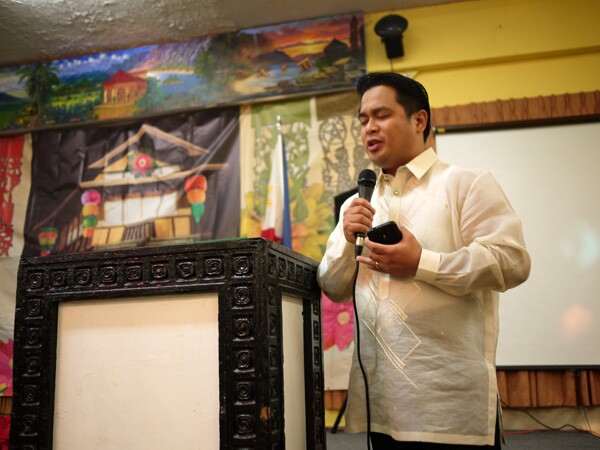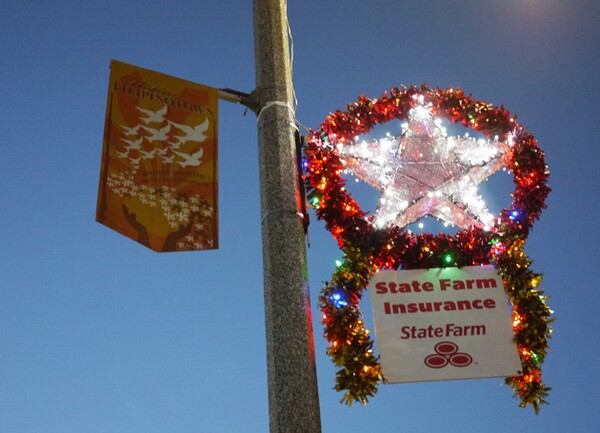Lighting Christmas Parols in Historic Filipinotown with Prayers for Victims of Typhoon Haiyan

Santa Claus, Christmas trees and mistletoes have become American symbols of the holiday season. For the Philippines and its diaspora that live across the globe, it is the parol (Christmas lantern) that occupies the primary symbol that represents the advent of the Christmas season. As of last week, L.A.'s own public version of parols are now erect along the street light posts of Temple Street in Historic Filipinotown, colorfully illuminating the thoroughfare at night.
On November 25, the Historic Filipinotown Neighborhood Council (HiFi NC) celebrated the 6th annual Polemount Parol Lighting, which included 31 local business- and family-sponsored parols that line Temple Street in Historic Filipinotown (HiFi), between Hoover Street and Glendale Boulevard. HiFi NC president Cecile Ramos sees the parols along Temple Street as not only a Filipino cultural tradition, but also a way to "align itself with the vision to strengthen the local business climate and help make Historic Filipinotown a tourist destination."
Parols are made to resemble the star of Bethlehem and its role as a light that guided the three wise men to Jesus. Traditionally made of bamboo, papél de Japón (Japanese rice paper), decorative tails, and a candle or coconut oil lamp for lighting, today's parols are made of various materials and come in different shapes. The Temple Street parols are made of metals, lights, and other materials, all approved by the city's Building and Safety Department since they are mounted on the street lamp posts that access the city's power grid.
Originating in the largest Catholic nation in Southeast Asia, the Philippine parol is influenced by Spanish colonial religious traditions and language, as farol in Spanish means lantern. The Mexican piñata, inspired by Italy and then Spain, also influenced the outdoor hanging of parols via the shared Spanish colonial history of the Philippines and Mexico.
Even though its religious origin is western Catholicism, the parol can be understood as a cultural symbol inherently rooted in local Philippine practices of faith and prayer. Used by villagers in the past, the parol guided the way to the Misas de Aguinaldo (Gift Masses) that started on December 16 and ended with the Misa de Gallo (Mass of the Rooster) on Christmas Eve. The parol continues to be the light that guides the Philippine people's Catholic spirituality, but also symbolizes sentiments of hope for a better situation in the face of life's challenges.


The lighting of the parol along HiFi's Temple Street took on extra significance this year as a symbol of hope, as the approximately 100 attendees at the FACLA (Filipino American Community of Los Angeles) community hall were weighed down with heavy hearts, sending prayers for the victims of the November 8 Typhoon Haiyan (aka Yolanda) in the Philippines. On record as one of the most devastating typhoons ever, organizers and speakers at the parol lighting event first held a vigil for the victims and reminded the crowd that this year's parol festivities must think about the home nation's current struggles. Local Philippine Consul General Helen De La Vega expressed that the parol lighting must be in remembrance of the "brothers and sisters grappling with hardship in the Philippines, and that the parol lighting must signify hope -- and that we must give donations to help the country back home."
Typhoon Haiyan has locally touched many in the Philippine diaspora in Los Angeles, including myself. My family on my father's side, who live in the town of Kalibo in the Western Visayan Islands province of Aklan, experienced part of their roof flying off and windows shattering during the typhoon. Fortunately for my family, no deaths were suffered. This can't be said for many other victims of Haiyan, as it has, as of today, officially claimed over 5,500 people, resulted in thousands missing and injured, and has displaced millions.
The relief effort has intensified across the world, including strong local efforts by the Filipino-American community and non-Filipinos alike. With the anticipated rising death toll and the arduous task of rebuilding, continued relief efforts and more donations will be sorely needed. Symbolic of the hope, faith, and spirit of giving that is needed, the lighted parols along Temple Street engage us Angelenos to think of the typhoon victims during this Christmas season, and hopefully encourages us to donate in support of the country's recovery.
For resources on how to support the relief efforts, please click on the following links:
National Alliance for Filipino Concerns
Photos by George Villanueva.